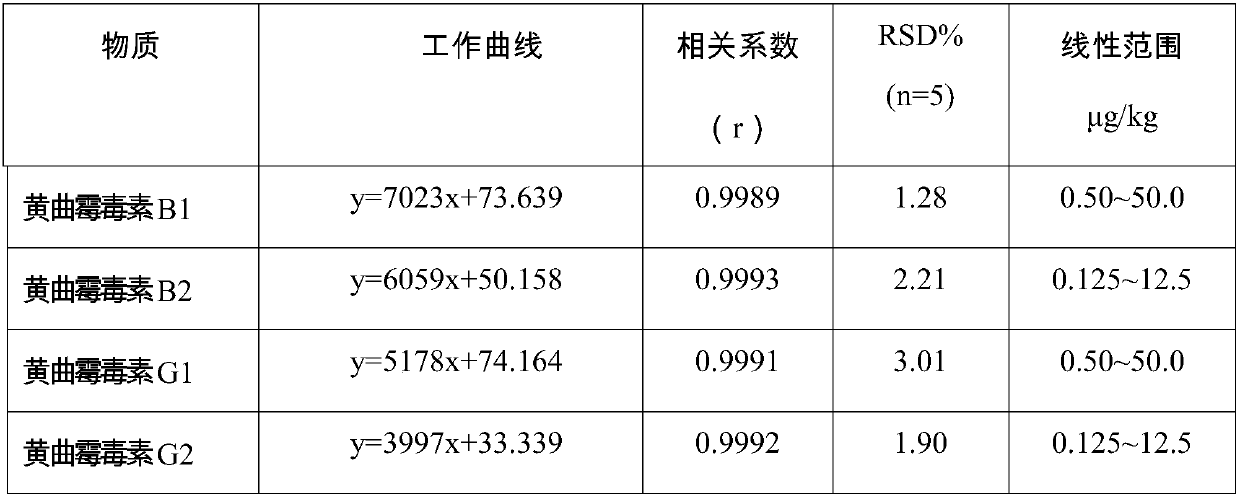A new method for rapid detection of aflatoxin in food
A technology of aflatoxin and a new method, which is applied to measuring devices, instruments, scientific instruments, etc., can solve the problems of difficult separation, poor purification effect, unclear materials used, etc., and achieves simple separation operation, good purification effect, and small dosage. Effect
- Summary
- Abstract
- Description
- Claims
- Application Information
AI Technical Summary
Problems solved by technology
Method used
Image
Examples
Embodiment 1
[0030] Embodiment 1 utilizes the present invention to detect the content of aflatoxin in peanut, and the steps are:
[0031] 1. Preparation of organic acid-coated magnetic nanomaterials: Weigh 4.10 g ferrous ammonium sulfate ((NH 4 ) 2 Fe(SO 4 ) 2 ·6H 2 O), 13.52g ferric chloride (FeCl 3 ·6H 2 0), after dissolving with 100mL deionized water, transfer to a 250mL three-necked bottle, under nitrogen protection, heat to 80°C in a water bath, mechanically stir for 10min (rotating speed is 1000rpm), then add 5mL methanol containing 200μL n-nonanoic acid solution, continue to stir for 5 minutes, add 10 mL of concentrated ammonia water, continue to react the mixed solution for 30 minutes, cool to room temperature naturally, collect the product with an external magnetic field and discard the reaction solution, and wash the magnetic material twice with 100 mL of deionized water and twice with 100 mL of methanol , washed three times with 100 mL deionized water, and dried in vacuum ...
Embodiment 2
[0040] Embodiment 2 Utilizes the present invention to detect the content of aflatoxin in corn, and the steps are:
[0041] 1. Preparation of organic acid-coated magnetic nanomaterials: Weigh 2.00 g of ferrous chloride (FeCl 2 4H 2 O), 5.40g ferric chloride (FeCl 3 ·6H 2 O), after dissolving with 100mL deionized water, transfer to a 250mL three-necked bottle, under nitrogen protection, mechanically stir for 15min (rotational speed is 600rpm) and water bath heating to 70°C, then add 5mL methanol containing 300μL n-decanoic acid solution, continue to stir for 5 minutes, add 15 mL of concentrated ammonia water, continue to react the mixture for 30 minutes, cool to room temperature naturally, collect the product with an external magnetic field and discard the reaction solution, and wash the magnetic material twice with 100 mL of deionized water and twice with 100 mL of methanol , washed twice with 100 mL of deionized water, and vacuum-dried at 80°C for 24 hours to obtain n-decan...
Embodiment 3
[0045] Embodiment 3 utilizes the present invention to detect the content of aflatoxin in the walnut, and the steps are:
[0046] 1. Preparation of organic acid-coated magnetic nanomaterials: Weigh 2.00 g of ferrous chloride (FeCl 2 4H 2 O), 5.62g iron sulfate (Fe 2 (SO 4 ) 3 9H2O), dissolved in 100mL deionized water, transferred to a 250mL three-necked bottle, under nitrogen protection, mechanically stirred for 12min (rotation speed: 800rpm) and heated to 85°C in a water bath, then added 5mL acetone containing 400μL oleic acid solution, continue to stir for 5 minutes, add 20 mL of concentrated ammonia water, continue to react the mixed solution for 30 minutes, cool to room temperature naturally, collect the product with an external magnetic field and discard the reaction solution, wash the magnetic material twice with 100 mL of deionized water, and wash three times with 100 mL of methanol , washed twice with 100 mL of deionized water, and dried in vacuum at 70° C. for 30 h...
PUM
 Login to View More
Login to View More Abstract
Description
Claims
Application Information
 Login to View More
Login to View More - R&D
- Intellectual Property
- Life Sciences
- Materials
- Tech Scout
- Unparalleled Data Quality
- Higher Quality Content
- 60% Fewer Hallucinations
Browse by: Latest US Patents, China's latest patents, Technical Efficacy Thesaurus, Application Domain, Technology Topic, Popular Technical Reports.
© 2025 PatSnap. All rights reserved.Legal|Privacy policy|Modern Slavery Act Transparency Statement|Sitemap|About US| Contact US: help@patsnap.com



